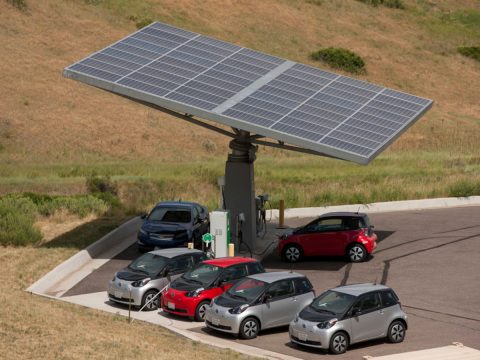
For nearly two years now, the transportation sector has accounted for more carbon dioxide emissions than those from the power sector, offering both challenges and opportunities in the transition to a clean energy economy.
Today, Alliance to Save Energy’s 50×50 Commission on U.S. Transportation Sector Efficiency released a report and launched a campaign to cut U.S. transportation energy use by 50 percent by 2050 (dubbed the “50×50” goal) while also improving mobility. Amid rapidly evolving transportation trends—like ride-sharing, electrification, autonomous vehicles, and other technologies—the commission is calling on policymakers to act urgently in a coordinated manner to electrify transportation and transform mobility.
For the past year, two dozen companies, organizations, and public officials have worked together to develop an agenda to make this vision a reality. The group, includes vehicle manufacturers, utilities, environmental and consumer groups, unions, technology companies, and mayors.
The target—cutting the energy used in U.S. transportation 50 percent by 2050 while meeting future mobility needs—is a bold one. But we believe it is reachable. By achieving it, we can lower transportation costs for families and businesses, improve our energy security, and protect the environment.
This is the right moment to plan this future because we’re on the verge of a transformational change in mobility. Ride-hailing apps are bringing a new convenience for millions of Americans. Electric and alternative fuel vehicles, which are quickly growing in numbers, are more energy efficient, lowering operating costs. And autonomous vehicles are going to reshape our daily routines, one day freeing our hands from the wheel.
Together, these technologies provide us with a chance to reinvent how we move people and goods. And if we get it right, we could use far less energy. But it won’t happen by itself; we need coordination, smart policy, and a strategy for capitalizing on this opportunity.
The 50×50 Commission’s agenda focuses on three themes:
Transform. Policymakers should not only seek to enhance the efficiency of vehicles, but to realize the energy savings of integrating our transportation into a seamless and well-coordinated system that encourages use of the most efficient modes of transport.
Innovate. The U.S. should prioritize its leadership in pursuing research and development of efficient transport technologies.
Invest. Congress should support the use of electric, hybrid, and efficient renewable natural gas vehicles through investments in charging and alternative fueling infrastructure, awareness campaigns, and incentives.
Throughout this transformation, policymakers need to ensure low-income and under-served consumers have access to improved mobility and that the workforce is well-prepared for the sector’s transitions.
We are on the cusp of a clean transportation shift in the U.S. that has the potential to increase mobility, make the air cleaner for everyone, and keep the U.S. auto industry globally competitive. Momentum for zero emission transit systems and vehicles has never been greater. This report is a blueprint for accelerating the transition to a clean transportation system that will increase access for all Americans and help cities thrive.
Patty Monahan, Program Director, Transportation